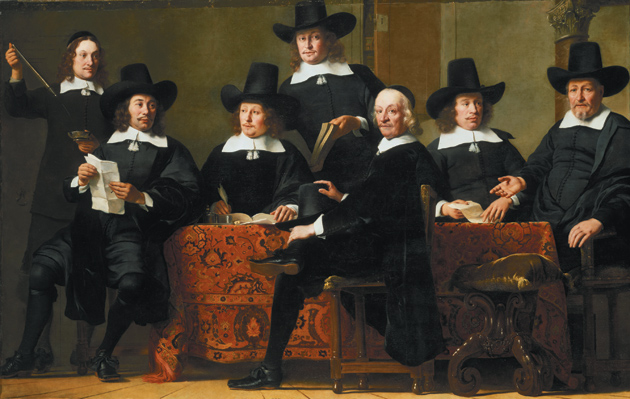Asked to review a book entitled Portrait and Individual, a well-known English historian dryly remarked that the portraits would probably tell him more about the society in which the sitters were painted than about the sitters themselves. The comment reminds us that while portraits from pre-modern times may give their subjects distinctive faces, they also show them as members of a particular class and family or as representatives of an office or institution. The individual—prince or prelate, patrician or professor—stands for the collective.
This public character of portrait painting is heightened in paintings that bring together an entire community made up of members of a public institution or corporation. Here we are confronted with a social phenomenon that art history alone is unable to explain. At a time when elsewhere in the absolutist Europe of the seventeenth century the public sphere was dominated by statues and portraits of princes, in the Dutch Republics the members of municipal corporations commissioned group portraits and paid for them collectively. This was a unique turn toward democracy in the history of portraiture.
In the language of art historians, these paintings have come to be known by the rather inadequate label “group portrait.” A designation corresponding to their social content would be more clarifying. Thus for the portraits of civil defense militias, the old name Schützenstück (musketeer piece) could be used; for those that assemble the overseers, or governors, of municipal foundations, the term Regentenstück (governor piece) would be better. Then there are anatomies (“cadaver paintings”), works in which a group of medical doctors and students surround a dead body—another distinct genre with its own social implications, for the dead bodies used were often those of the very poor. The more concrete designations place us in the midst of urban life.
These portraits arose in the Dutch Republics after the Dutch Revolt—the uprising that began in 1568 in which the Dutch, especially in Amsterdam, shook off the hated rule of Catholic Spain. They are the artistic expression of a newly acquired bourgeois freedom. Even the conventional ways in which the subjects are lined up are a result of the democratic upheaval; after all, each member of a municipal militia wanted to appear in his appropriate place, just as do the heads of state in today’s painfully awkward group photos at G-20 summits. Some musketeer portraits are astonishingly wide in order to allow all their ambitious subjects to line up side by side and as equitably as possible, without any hint of subordination to disturb the social harmony. For Dutch portraitists these were restrictive constraints and it took the genius of Rembrandt or Frans Hals to fill this standardized genre with dramatic life.
Ordinarily, one sees these portraits of musketeers and governors only in Dutch museums. Their gigantic proportions make it difficult for them to travel on loan. Moreover, this very Dutch genre is more challenging for foreign audiences to interpret than the Dutch landscapes, genre paintings, and still lifes so familiar to all the world. A few years ago, Munich had the good fortune to be able to view Frans Hals’s portraits of Haarlem governors in an exhibition at the Hypo-Kunsthalle—a memorable experience. Now the Amsterdam Historical Museum, at present undergoing renovations, has loaned eleven large group portraits first to Vienna and now to the Alte Pinakothek in Munich, which has added its own picture by Ferdinand Bol to the others. There are five group portraits of musketeers, five of governors, and one cadaver portrait. In their day, they hung in the buildings that housed the militias, guilds, and charitable overseers that were portrayed. Because of their artistic and historical interest, they eventually found their way to the Rijksmuseum and the Amsterdam Historical Museum, which has more than a hundred of them.
Four of the paintings of musketeers have been assembled in one gallery where they make an imposing show. The oldest dates from 1596 and shows the militia of Captain Hoying. The picture, ascribed to Pieter Isaacsz, used to hang in the great hall of the Harquebus House. The desire of citizen-militiamen for self-display determines the unusual form of the painting. It extends horizontally more than sixteen feet so that all twenty-two musketeers have ample room to stand side by side. Only a few carry weapons. Most are dressed in civilian clothes, usually black with the customary ruff. The sharpest color accent is an ensign’s uniform of silver silk. The militiamen are lined up around their captain and their own flag, as if on a stage. Each man has paid for and received his true likeness.
The 1611 portrait by Frans Badens of the officers and musketeers of Amsterdam’s Seventh District is quite different, with the faces appearing in two rows, one above the other. The middle of the painting affords a prospect out into the open, where the weapon racks of the rest of the company can be seen. Captain, lieutenant, ensign, and drummer are located up front as if on the apron of a stage, the lieutenant resplendent in richly decorated armor. The public appearances of these citizen militias involved a certain amount of ostentation. Each man looks directly into the eyes of the observer just as in nineteenth-century club photographs.
Advertisement
In the early seventeenth century Amsterdam was growing more and more prosperous. The appearance of the militias became more civilized as the military threat waned and the duty to be vigilant lost some of its urgency. Norbert Eilasz’s portrait of Captain Backer’s company shows the musketeers at a festive supper. Their captain with his napkin sits at the head of the table. Capons are being carved and a pie sliced. The theme of musketeers at table was not new, but here it entices the artist to portray a relaxed scene of sensual pleasure.
In 1648—the year the Peace of Westphalia brought an end to the Thirty Years’ War—in Govert Flinck’s painting of Captain Huydecoper, we see that Rembrandt’s The Night Watch of 1642 had revolutionized the musketeer genre. Flinck’s canvas turns the portrait of a militia into a completely theatrical scene. The stout captain with a blue sash over his shoulder has just emerged from the militia headquarters to welcome the dapper lieutenant and his entourage. Bonfires burn in the background. A contemporary poem in praise of Captain Huydecoper declares, “Spirit and valor, the strength of free cities, overcome the old rancor and cast off the garments of war.”
The temperature drops markedly when we come to portraits of powerful civilian “governors” of commerce, poorhouses, and much else. The well-lubricated conviviality of the musketeer paintings fades away. Here the dominant color is black and instead of the civil defense forces, one is confronted by the searching gazes of the overseers of trade and commerce in the municipal commonwealth. The character of these portraits is determined—sometimes frighteningly so—by the moral side of early capitalist society and its desire for discipline, industriousness, and well-ordered accounting. Here the exhibition becomes a lesson in social history.
The pictures display various municipal institutions. There are the officers of the guilds, black-clad gentlemen in hats gathered around a table covered with a reddish Oriental carpet, inspecting papers and ledgers. They look out from the picture with aloof and scrutinizing faces. They are responsible for money and business and their portraits are meant to inspire trust. Ferdinand Bol’s painting of the directors of the wine merchants’ guild—the only canvas from the Alte Pinakothek’s own collection—makes a surprisingly fresh impression among its new companions. In Gerbrand van den Eeckhout’s portrait of the representatives of the coopers’ and wine bottlers’ guild, we see on the rear wall a statue of the Apostle Matthew, their patron saint from the days of Catholicism. In front of the table are a barrel and a copper vessel for sampling imported wines. In its gradations of gray, black, red, and brown it is a lovely painting, yet replete with business sense, comfortable, and somewhat lethargic.
The portraits of the male and female governors of municipal charities and houses of correction wear a different face. In 1649, Ferdinand Bol painted the Lepers’ House. Again, four older gentlemen have assembled around a table. Two seem to be occupied with an account book. The other two are inspecting a small boy standing timidly before the great men who will decide whether to admit him into the home. It is both touching and frightening. The double face of a charitable impulse that looks after the sick by locking them away is impressively captured in this painting.
This impression is only reinforced when we turn to the governors of the Amsterdam Spinning House. Since 1596 the city had maintained a prison for loose women—pickpockets, prostitutes, and the like. They were obliged to work spinning yarn. In 1650, Bartholomäus van der Helst painted the men and women who directed this institution. Well-fed, they sit at a table discussing its finances and administration. But behind them appears a grim scene, for we can see into the work room of the spinners. A matron is beating one of the harlots with her shoe while burghers watch the malefactor’s punishment through a grille; the price of admission to observe such scenes was two stuivers. Above the entrance to the Spinning House stood the motto, “My hand brings punishment but my soul is loving.” Here we catch a glimpse of the spiritual nadir of this moralizing merchant society.
Advertisement
The catalog is reminiscent of a famous essay on Dutch group portraits by the Viennese art historian Alois Riegl, a masterpiece of aesthetic analysis. Today, dismayed by crises in the financial and banking system, we read these pictures in a more concrete way, as the self-images of an early democratic society no longer founded on aristocracy and church but rather on finance and business. In Munich’s Alte Pinakothek, where the reigning prince is Rubens, the painter of the Catholic Spanish Low Countries, this strikes a strange chord, and underlines the darker qualities revealed in “A Golden Age: Dutch Group Portraits.”
This Issue
February 10, 2011




